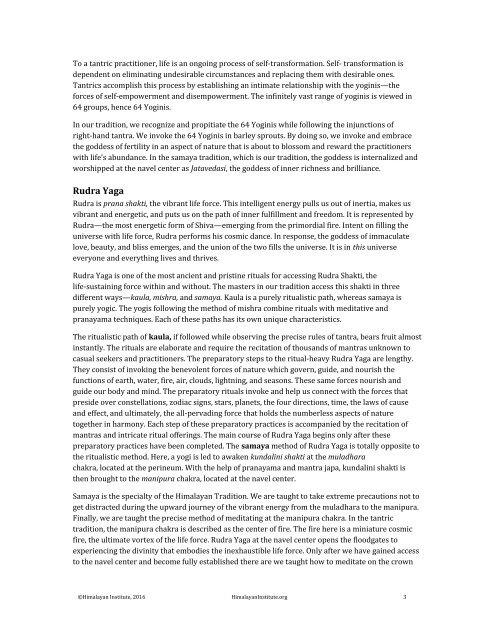Tantric Rituals Tantric Meditation
NY-Immersion-Program-Guide-1
NY-Immersion-Program-Guide-1
You also want an ePaper? Increase the reach of your titles
YUMPU automatically turns print PDFs into web optimized ePapers that Google loves.
To a tantric practitioner, life is an ongoing process of selftransformation. Self transformation is<br />
dependent on eliminating undesirable circumstances and replacing them with desirable ones.<br />
<strong>Tantric</strong>s accomplish this process by establishing an intimate relationship with the yoginis—the<br />
forces of selfempowerment and disempowerment. The infinitely vast range of yoginis is viewed in<br />
64 groups, hence 64 Yoginis.<br />
In our tradition, we recognize and propitiate the 64 Yoginis while following the injunctions of<br />
righthand tantra. We invoke the 64 Yoginis in barley sprouts. By doing so, we invoke and embrace<br />
the goddess of fertility in an aspect of nature that is about to blossom and reward the practitioners<br />
with life’s abundance. In the samaya tradition, which is our tradition, the goddess is internalized and<br />
worshipped at the navel center as Jatavedasi , the goddess of inner richness and brilliance.<br />
Rudra Yaga<br />
Rudra is prana shakti, the vibrant life force. This intelligent energy pulls us out of inertia, makes us<br />
vibrant and energetic, and puts us on the path of inner fulfillment and freedom. It is represented by<br />
Rudra—the most energetic form of Shiva—emerging from the primordial fire. Intent on filling the<br />
universe with life force, Rudra performs his cosmic dance. In response, the goddess of immaculate<br />
love, beauty, and bliss emerges, and the union of the two fills the universe. It is in this universe<br />
everyone and everything lives and thrives.<br />
Rudra Yaga is one of the most ancient and pristine rituals for accessing Rudra Shakti, the<br />
lifesustaining force within and without. The masters in our tradition access this shakti in three<br />
different ways— kaula, mishra, and samaya. Kaula is a purely ritualistic path, whereas samaya is<br />
purely yogic. The yogis following the method of mishra combine rituals with meditative and<br />
pranayama techniques. Each of these paths has its own unique characteristics.<br />
The ritualistic path of kaula, if followed while observing the precise rules of tantra, bears fruit almost<br />
instantly. The rituals are elaborate and require the recitation of thousands of mantras unknown to<br />
casual seekers and practitioners. The preparatory steps to the ritualheavy Rudra Yaga are lengthy.<br />
They consist of invoking the benevolent forces of nature which govern, guide, and nourish the<br />
functions of earth, water, fire, air, clouds, lightning, and seasons. These same forces nourish and<br />
guide our body and mind. The preparatory rituals invoke and help us connect with the forces that<br />
preside over constellations, zodiac signs, stars, planets, the four directions, time, the laws of cause<br />
and effect, and ultimately, the allpervading force that holds the numberless aspects of nature<br />
together in harmony. Each step of these preparatory practices is accompanied by the recitation of<br />
mantras and intricate ritual offerings. The main course of Rudra Yaga begins only after these<br />
preparatory practices have been completed. The samaya method of Rudra Yaga is totally opposite to<br />
the ritualistic method. Here, a yogi is led to awaken kundalini shakti at the muladhara<br />
chakra, located at the perineum. With the help of pranayama and mantra japa, kundalini shakti is<br />
then brought to the manipura chakra, located at the navel center.<br />
Samaya is the specialty of the Himalayan Tradition. We are taught to take extreme precautions not to<br />
get distracted during the upward journey of the vibrant energy from the muladhara to the manipura.<br />
Finally, we are taught the precise method of meditating at the manipura chakra. In the tantric<br />
tradition, the manipura chakra is described as the center of fire. The fire here is a miniature cosmic<br />
fire, the ultimate vortex of the life force. Rudra Yaga at the navel center opens the floodgates to<br />
experiencing the divinity that embodies the inexhaustible life force. Only after we have gained access<br />
to the navel center and become fully established there are we taught how to meditate on the crown<br />
©Himalayan Institute, 2016 HimalayanInstitute.org 3


